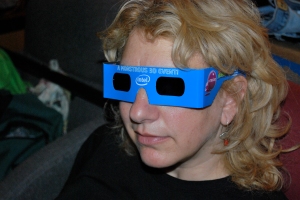Having worked first in film production, and spending 10 years in selling, training, reviewing, and consumer education in home theater, I am what most would call somewhat of a videophile. I love a good picture, that is crisp, detailed, and has realistic color. And I have grown to love audio that brings the musicians or the action into my room. Once high definition TV came on the scene, the picture and today’s higher definition TVs thrilled me and high def disc players are even more true-to-life, more detailed.
In the years on the sales floor selling home theater, I learned about Monster Cable and did my own blind tests (and continue to do so today). Often, I could see actual differences—better contrast, richer color, more details, less interference and artifacts—when I upgraded my cables and even when I couldn’t pinpoint it, I noticed a “feel” of more realism.
I have heard that digital cables are all the same, but have seen for myself and since learned by interviewing the engineers and inventors of HDMI, this is not at all true, particularly with advanced high definition TVs and sources. There is a lot of information being transferred over cables with higher definition video and uncompressed audio. Steps must be taken to ensure that all of the signal arrives at the right time without digital packets of information being dropped, or interference altering the packets and creating artifacts, digital snow, or other picture degradations. This is much more apparent on today’s big screen TVs.
A quality cable that has been tested to be sure that all of the signal arrives at the right time is essential to get all of the performance possible from the components and TV. First, being sure that signal is not lost via poor soldering of the connectors to the wires. And being sure that the cable does not lose signal or gain interference by having a well-insulated cable. And finally, choosing the cable that is speed tested to get me the best performance for the gear that I am connecting. If I am connecting a satellite or cable box with 1080i, compressed video, it’s appropriate that I buy a less expensive standard speed, quality HDMI cable. If, however, I want the best from my Blu-ray Disc player (that I may have spent $1000 for plus $30 per movie) I am going to want to get an ultimate high-speed, quality HDMI cable. And I’m even happier if I buy a “Cable for Life” so I don’t have to purchase another cable in a couple of years because technology has advanced. These are the quality features available on Monster Cables speed rated HDMI cables.
If I’ve spent thousands of dollars on a high definition TV and high def player, and I’m spending money each month for high definition programming, I don’t think skimping on cables for a one time, extra $50 to $100 is a wise decision. I bought a 1080p, FULL HD TV because I want that improved picture quality. A few more dollars to make sure that I get all that I paid for is worth it to me.
Barb Gonzalez
The Simple Tech Guru
Note: Because of my passion for home theater quality, I have decided to work with Monster Cable on consumer education. We are working together to simplify buying, hooking up and setting up home theaters through a book, Home Theater Made Simple, web education and the monstercommunity forum. Look for my blog and tips at http://www.monstercommunity.com.
 I attended CES 2009 in Las Vegas at the beginning of January and reported that 3D TV was everywhere. Today’s Superbowl commercials for “Monsters and Aliens” illustrated my point. We were at a Superbowl party where we had the 3D glasses to watch the Superbowl commercials for the Disney/Dreamworks film and for Sobe drinks. Sitting close to the Sony 60 inch DLP HDTV, wearing our paper 3D glasses, objects popped out of the TV and came at us. The picture of the 3D glasses floated in mid air and the paddle ball came straight at us. Papers floated into the room from the screen. Yes, this was real 3D on our TV. We hooted and hollered. Some of the people at the back of the room sitting high up on director’s chairs did not get the same affect, but we in the front were hooked in.
I attended CES 2009 in Las Vegas at the beginning of January and reported that 3D TV was everywhere. Today’s Superbowl commercials for “Monsters and Aliens” illustrated my point. We were at a Superbowl party where we had the 3D glasses to watch the Superbowl commercials for the Disney/Dreamworks film and for Sobe drinks. Sitting close to the Sony 60 inch DLP HDTV, wearing our paper 3D glasses, objects popped out of the TV and came at us. The picture of the 3D glasses floated in mid air and the paddle ball came straight at us. Papers floated into the room from the screen. Yes, this was real 3D on our TV. We hooted and hollered. Some of the people at the back of the room sitting high up on director’s chairs did not get the same affect, but we in the front were hooked in.


